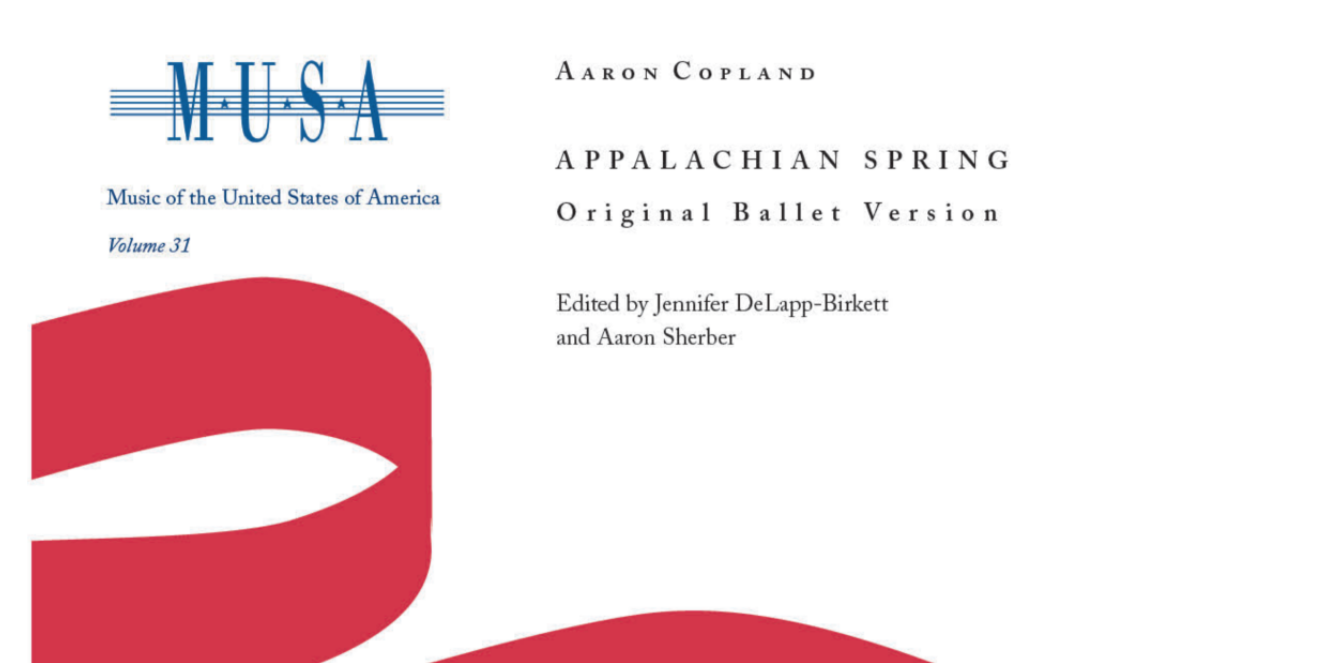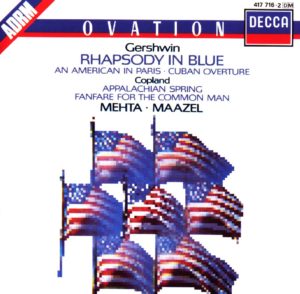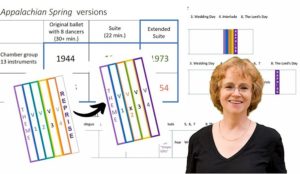
Once in a while a book is published that completely fills a void. That is certainly the case with Appalachian Spring Original Ballet Version produced by Music of the United States of America (MUSA) and edited by Jennifer DeLapp-Birkett and Aaron Sherber.
I’m a bit slow off the mark with my review of this (it was published in 2020 as part of the 75th anniversary celebrations of Appalachian Spring). Nonetheless, as we approach the 80th anniversary, I want to share with you just how valuable I think this publication is. Here’s a few reasons:
- It presents (unbelievably) for the very first time the complete engraving of Copland’s original ballet score for 13 instruments. Described as the “critical edition” it is the definitive published score of the draft that Aaron Copland presented to Martha Graham back in 1944 and the version that the Martha Graham Dance Company have been dancing to ever since.
- It unpicks and makes sense of each of the six (yes six!) versions of Appalachian Spring that exist. This is an absolute boon as for years, programmers, record companies, orchestras, conductors and even Copland himself have mixed up the different versions!
- If this wasn’t enough, then the thing that should be interesting to any Aaron Copland or Martha Graham fan is the fact that each page of music has two images of the 1958 Nathan Kroll directed televised version of the ballet (danced by the incredibly sprightly, 64-year-old Martha Graham!) As I don’t read music, this is a tremendous asset. In total there are 365 still images from the ballet.
All in all the Appalachian Spring MUSA Edition is an invaluable resource and no doubt will be used by many musicians and dancers, academics and musicologists as well as interested people like me. Anyone who loves Appalachian Spring will be indebted to the authors and MUSA for this volume. I am sure that Copland himself would have been overjoyed too.
My 30+ year relationship with Appalachian Spring
 Back in the early 90’s Appalachian Spring was the Copland piece that sealed the deal for me. The first recording I heard was the suite version performed by the New York Philharmonic conducted by Zubin Mehta.
Back in the early 90’s Appalachian Spring was the Copland piece that sealed the deal for me. The first recording I heard was the suite version performed by the New York Philharmonic conducted by Zubin Mehta.
In, 1990, the year that Copland died, the first original ballet versions for 13 instruments were recorded (by Andrew Schenck and the Atlantic Sinfonietta and Hugh Wolff and the St Paul Chamber Orchestra). I stumbled across a CD copy of the latter at the Bristol Central Library. I was intrigued to hear the full ballet and I was duly blown away. When I started going to Copland concerts a few years later I wanted to hear this version. However, even when the flyers promised the “complete” ballet or the “original chamber version” or the “ballet for 13 instruments”, in every case what ended up being performed was the suite version. It was frustrating.
Don’t get me wrong, I liked the suite, but the original incarnation, the music that the Martha Graham Dance Company performed to was so much more. Not only in length, but there were spiky bits that I felt made it more interesting and real whilst the instrumentation seemed cleaner, more precise. In comparison, the suite can sometimes sound a bit too, dare I say….. Disney.

I have all the different versions on CD
I didn’t realise at first, the fact that six different versions were out there. The problem was that the music from the original was never published. Copland made the suite in 1945 which involved scaled up orchestration for a largish orchestra, some cuts (around 8 minutes of music) and alterations to the Simple Gifts variations. The suite version was so successful that when Copland was asked in 1954 to orchestrate the complete ballet he used some of his later modifications. In 1973, he recorded what Sony states as the “First Recording of the Original Version” and that again has the changed order of the Simple Gift Variations. This recording was the one that was selected by BBC Radio 3 as their Building a Library choice. I remember buying it and immediately realising something was wrong. (I was very disappointed that of all the candidates considered in that programme, my favourite wasn’t amongst them – I cry Foul!).
There were other endorsed adaptations with more strings too. Once in a while I tried to work it all out and compare one version with another and see if I could hear the difference. Not easy when you have to replace one CD with another or try and listen consecutively with two different devices. But this was made even more difficult because of the engineering of different recordings. Some like Copland: The Populist (Michael Tilson Thomas and the San Francisco Symphony Orchestra) are presented as a single movement of 35 minutes whilst others are broken down into individual sections. But there is no consistency, in terms of what constitutes a section or what it is called. It made my head hurt!
What is so helpful to me is that the Appalachian Spring MUSA Edition is very much the companion volume to the St Paul Chamber Orchestra/Hugh Wolff recording as each section of the ballet as engineered on the CD relates to the score so I can easily find the page of music and see exactly what is happening in the dance. That’s a real thrill.
34 years on – I still have not seen Appalachian Spring danced live with Martha Graham’s choreography. It’s on the bucket list and will definitely happen at some point. I must admit to becoming a lot less worried about the possibility of missing out on this when I realised that the 1958 televised production is available on YouTube. In addition, the companion website appalachianspring.info has an archive recording from 1947 and a welcome recent performance from the present-day Graham company.
My problem with Simple Gifts
What I have omitted to say above is that I have always had a bit of an issue with Appalachian Spring. For years, I have kept it to myself but I now feel confident enough to admit it! I am not fond of Simple Gifts! I’m not really sure I even like it that much! In fact, if it weren’t for the association with Copland, I think I would have filed it away with Morning from Peer Gynt and the Peter and the Wolf theme as “ear worms to be avoided”!
Now the reason for this is not because of the Shaker Tune ‘Tis the Gift to be Simple or how Copland used it but how it in turn was adapted into the modern hymn The Lord of the Dance. When I was a kid this was one of the hymns that I loathed. I am sure there are many people that love The Lord of the Dance but it has always made me cringe or even shudder. My father is Irish but this hymn has always seemed to me to be way too Oirish. Give me Be Thou My Vision any day of the week.
 I remember the first time I listened to the suite version and how my heart sunk when I suddenly heard this familiar tune. I immediately consulted the liner notes and was perplexed that it didn’t mention anything about The Lord of the Dance. I think it highly likely that this aversion is one of the reasons why I navigate so firmly to the original ballet version where the order of variations is different and split by the dissonant middle section. Again, Delapp-Birkett has produced a couple of nice simple diagrams showing how the order of the variations differs in the ballet and two other versions of the suite. (This is well explained in the book but there are also some video explainers here: Midday Thoughts: The Many Versions of Appalachian Spring
I remember the first time I listened to the suite version and how my heart sunk when I suddenly heard this familiar tune. I immediately consulted the liner notes and was perplexed that it didn’t mention anything about The Lord of the Dance. I think it highly likely that this aversion is one of the reasons why I navigate so firmly to the original ballet version where the order of variations is different and split by the dissonant middle section. Again, Delapp-Birkett has produced a couple of nice simple diagrams showing how the order of the variations differs in the ballet and two other versions of the suite. (This is well explained in the book but there are also some video explainers here: Midday Thoughts: The Many Versions of Appalachian Spring
The book Connotations has a really illuminating and highly recommended chapter on this very subject called Simple Gifts and Complex Accretions by William Brooks. It goes into depth on how Copland’s suite version of the music has taken on a life of its own as it became assimilated into American consciousness. I’m paraphrasing, but the essay suggests that it divides opinion: Some people consider the Shaker hymn as an alternative national anthem whilst to some listeners, like me, it’s cloying and twee and for others just a bit too “immaculate white”. On reading the essay I realised that perhaps I was not alone in struggling with this bit of the music.
Blog of Revelations
 As someone who gets a kick out of Copland’s more acerbic works, I love the space dedicated in the Appalachian Spring MUSA Edition to the 8 minutes of “incidental music” that Copland extracted from the suite. These sections are described as Fear in the Night, Day of Wrath and Moment of Crisis. I am really intrigued by this part of the ballet. I have previously described it as the grit that begets the pearl. I love the frenzied dancing of the Preacher in the Fear in the Night and then the Bride in Moment of Crisis. A book like this will always get me thinking. During reading this, something suddenly struck me. Day of Wrath translates as Dies Irae! Who would have thought? Copland wrote a Dies Irae! I have never seen this mentioned in anything I have read but surely it must have occurred to Copland? I bet he was quite pleased to have one in his catalogue! This said, if this is indeed meant as a Dies Irae, it sounds nothing like those written by Mozart or Verdi in their Requiem Masses. In fact, the music from Fear in the Night or Moment of Crisis is much more like those. By contrast, Copland’s Day of Wrath sounds like a calm interlude between storms. I will ask Jennier Delapp-Birkett if she has any views on this.
As someone who gets a kick out of Copland’s more acerbic works, I love the space dedicated in the Appalachian Spring MUSA Edition to the 8 minutes of “incidental music” that Copland extracted from the suite. These sections are described as Fear in the Night, Day of Wrath and Moment of Crisis. I am really intrigued by this part of the ballet. I have previously described it as the grit that begets the pearl. I love the frenzied dancing of the Preacher in the Fear in the Night and then the Bride in Moment of Crisis. A book like this will always get me thinking. During reading this, something suddenly struck me. Day of Wrath translates as Dies Irae! Who would have thought? Copland wrote a Dies Irae! I have never seen this mentioned in anything I have read but surely it must have occurred to Copland? I bet he was quite pleased to have one in his catalogue! This said, if this is indeed meant as a Dies Irae, it sounds nothing like those written by Mozart or Verdi in their Requiem Masses. In fact, the music from Fear in the Night or Moment of Crisis is much more like those. By contrast, Copland’s Day of Wrath sounds like a calm interlude between storms. I will ask Jennier Delapp-Birkett if she has any views on this.
I don’t feel I can criticise this book as it is nigh on perfect with microscopic attention to detail. One thing that isn’t mentioned that is probably worthy of comment is that the Fear in the Night section was the only bit of recycled music that Copland took from a different project. It was part of the incidental music of Quiet City (Listen to the Christopher Brellochs reconstruction to hear that). Annegret Fauser’s Oxford Keynotes on Appalachian Spring describes this section as being “the most filmic in terms of its use of disconnected gestures, “hurry” music and isolated “stingers”.
The Appalachian Spring plot
The commentary doesn’t try to interpret the meaning of the ballet. It mainly sticks to describing the music and which characters are dancing. That’s fine as I don’t think that was ever part of the remit. However, it’s interesting that down the years I have really struggled to find an Idiot’s Guide to the plot. Even Annegret Fauser’s Oxford Keynotes falls short on this – unfortunately that slim volume is still too technical for my small brain (I’ll have to write a post myself at some point).
I have always been intrigued as to the Husbandman’s wave at the end of Very deliberate and the Bride’s subsequent Moment of Crisis. Does he go to war? Does he survive? Does she give birth? Does the baby survive? Are the Husbandman’s later appearances real or as a ghost? It’s all a bit ambiguous. The book that comes closest and offers the most satisfying description of what I think I am seeing in the ballet can be found in Music for the Common Man: Aaron Copland during the Depression and War by Elisabeth B Crist. The sub chapter On Loss and Mourning in Appalachian Spring makes it much more obvious that the Husbandman’s reappearance towards the end of the ballet is as a spirit or a memory, another futile casualty of war.
This again shows why I like the full ballet version. I don’t think you could ever come to that conclusion from listening to the suite.
Coda
Over the years the number of times I listen to Appalachian Spring has dwindled. It’s not that I don’t still love this music. It’s just that I prefer to space out the listens. If I’m honest, I think I was scared that too much familiarity would lead to ambivalence. I wanted to preserve that delightful freshness that I got when I heard it in my 20s. A book like this really helps because it provides many answers and unveils many more layers of intrigue. In addition, it raises questions in ones own mind and leaves room for more self-study. Apologies in advance for the very bad pun…. But honestly,
if you know anyone who loves Appalachian Spring, this is quite possibly the Simplest Gift that you will ever have to buy”
Picture credit:
Aaron Copland Fund for Music
Book details:
Softcover: 227 pages
Publisher: A-R Editions, American Musicological Society (2020)
Language: English
ISBN 978-1-9872-0458-2







Leave a Comment